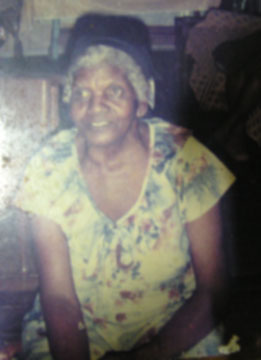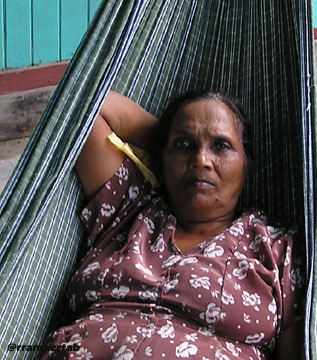| by Rakesh Rampertab |
I In the annals of East Indian music of Guyana, the contribution of women who worked on the plantations and estates is unquestionably extraordinary. For generations, a group of women from Grove, East Bank Demerara—all members of a weeding gang, made some of the most remarkable folk music. While this essay attempts to celebrate two of them—Elsie Sargeant popularly known as “Dougla” Elsie and Kassri Narine, called Kathy (kay-tee)—it also honor in spirit, their multi-talented supporting cast, all of whom have since died; Sundarie, "Polo," Sumintra aka “Lada,” Budnee, Dulari called “Sardaren,” Kawalpatie, and Sajaan Ramotar. Each was a singer in her own right, and many were efficient on the dholak (drum). “Dougla” Elsie was born to an Indian mother and a Black father in the early twenties, in Plantation Diamond (Diamond) on the East Bank of Demerara, bedrock of East Indian culture before its inhabitants migrated from the logees to Grove next door. As her mother died shortly after Elsie was born, the child came of age under the tutelage of a grandmother who came from India. Young Elsie started singing early, but would become most notable after her marriage, and move to Grove in the fifties. Essentially a folklorist like many musicians of the old, she lacked any formal education (music or otherwise), but knew how to sing between vernaculars and was familiar with the Hindu culture practiced locally. Apart from having the most distinct voice among her companions, she played the dholak, damru (small hand-drum), harmonium, and knew the homogenous lingua franca used on the plantations. To interpret the life of this cultural pioneer is not easy, because Elsie the musician evolved hand-in-hand with the very culture of Indian music which, incidentally, metamorphose due to the indenture experience, and was further complicated by its overlapping with the world of Western music. Thus, in playing music for the community from weddings to “nine-day” birth rituals to religious ceremonies, these estate-employed women existed between traditions.
Recently, I listened to a number of songs by these women from Grove, recorded by Peter Kempadoo and Marc Matthews in the early seventies. Thirty years later, it is altogether, a mesmerizing display of musical talent and feminine energy. The setting is raw with no acoustics to capture or purify sounds, and the instruments are rudimentary; there is a relentless dholak, backed by the undying presence of dhandtal and manjiras (or kartal; cymbals), and occasionally, tali (handclapping). The harmonium was set very low. While Elsie (who had an extensive repertoire of songs; a different type of song for differing occasions) was mostly the lead singer, she did not always lead. In fact, at least four of the women lead at one time or another.
From these recordings, Kempadoo-Matthews would “cut” a record of Elsie singing “Bangali Babu,” a song originally sung by a musician from Portuguese Quarter, Berbice, but which was truly popularized by Elsie. In the up-tempo “Shivaji Mandir,” which seems to resemble the intricate but traditional 14-beat chowtaal, the women encourage us to attend mandirs and sing the name of the God; and “Garam Massala” (Elsie, lead vocal) is a folk song that incorporated subtle ribaldry—using spicy Indian food items to describe the vivaciousness of “dis time young gyal” regarding courtship. A Bhojpuri recitation, which is customarily sung as Elsie Sargeant aka "Dugla Elsie." a dulaha and dulahin enter under the manro (ceremonial tent) in a Hindu wedding, is heard for a staggering four and a half minutes—all vocals and no instruments. One cannot exaggerate the role of music in the life of Indians, where it has surpassed itself as an art form, becoming life itself. This was best exemplified by these weeding-gang musicians whose “life” belonged to the community. What they played to the villagers, were often rehearsed in the cane fields where saucepans and cutlasses became dholaks and dhandtals. It seemed unnatural, but underlying these recordings is an intensity that is characterized by all these years of impromptu versification. These women were so devoted that they often attended Friday night matikors and return home after the kanghan on Monday. Elsie’s son, nicknamed “Bongo,” one of her five children and former member of the sixties’ Chandi Orchestra from Grove—laughed in remembering his father Dalfus who “would cuss” sometimes upon coming home to find his wife gone.
II Kassri Narine (aka Kathy), whose house is just one block from where Elsie lived, arrived last year in a rare visit to Guyana from Venezuela where she now lives. I met her quite “accidentally” while researching the music of Grove. Increased hardship under the PNC regime and the murder of her brother by bandits, led to her moving across the border to spend her last years. The idea that here was one of the community’s legendary folk singers—seemed feeble when it dawned upon me that neither music nor history was on her mind. Perhaps it was because the old “songster” (which is what musicians of the old were referred by) was very sick. She was born in 1934 in what was originally “old” Grove (before the nuclear scheme was added), not far from where the first Diamond-Grove mandir existed (at the border of the villages). One of the first mandirs in Demerara, it was here (before the reign of the Deodat Sharma clan of pundits) under Pandit Durga (father of PPP MP Reepu Daman Persaud) that Hindu culture thrived—such as, allegedly, the first-ever staging of the Ramlila pageant-plays, based on the Ramayana. This community would have influenced her tremendously, as it did Elsie.
In 1973, two of her songs became records—one was “Oh Maninja,” a folk anthem or “rhyme song” re-popularize by Kanchan in the eighties. For the Kempadoo-Matthews JARAI sessions, Kathy sang a different (probably the earliest) version of the song. Kassri Narine, aka "Kathy." The record that was made, however, was done from a different session in Grove at the home of Sugrim Gobin, in a room constructed specially “for recording music.” Of course, it was primitive—a mere room with high, sealed walls to deflect car engines and dog barks. Two of Grove’s well-known talents played on that record; Harrychan on dholak and Arthur Etwaroo (aka Arthur Barber) on harmonium. To capture the sounds from which a master tape was used to press the 45 records, Kathy used a tape recorder. In all of the folk literature to originate from
the East Indians, there is almost no verse that is as poignant
and famous as the chorus of “Oh Maninja.” Unwisely,
as has been generally the case with East Indian writings—not
regarded as proper culture by the guardians of Guyanese literature,
these lyrics have long been ignored; The song epitomizes the appalling realities of
estate village life; there is stark poverty, rising cost of living,
hard labor for little returns, thriftiness, brute estate management,
and despair.
III Grove lost its great music culture long ago as it began to lose its music matriarchs. As generations changed, musicians migrated elsewhere or passed on; Arthur “Rock N Roll” Budram left for the city and Leonard Latachana (Chandi Orchestra) migrated to Canada. Others like Ata Baba, Raymond Bandhu, and the spirited women of the weeding gang died. Chandi Orchestra that toured Suriname disbanded and Sugrim Gobin, who had made about a dozen records, moved to Friendship—only to be murdered by “kick-down-the-door” bandits. After Kathy moved to Venezuela, Elsie remained as the last of the musicians in Grove.
Acknowledgement [Editor's Note: This article first appeared in Stabroek News on May 29, 2005, as part of an onging series on Guyanese creative personalities, edited by Dr. Vincent Cambridge.] |
©
2001 Guyanaundersiege.com |
 While
hearing the recordings today suggests some primitiveness, there
is hardly a sense of trepidation, of mishaps between keys by these
estate women who, undeniably, were at ease in the business at
hand. One is awed at the movement between music scales, sub-genres
of songs, and of course, vernaculars—from a sohar or “birth
song” to a bhajan to an adamant anti-British East Indian
folk song (Elsie, lead vocal) sung in Anglo-Indian dialect, to
a medley of English nursery rhymes (e.g., “Mary Had a Little
Lamb”) to which—yes, was added a Bhojpuri refrain
to the common quatrains that used the a,b,a,b rhyme scheme.
While
hearing the recordings today suggests some primitiveness, there
is hardly a sense of trepidation, of mishaps between keys by these
estate women who, undeniably, were at ease in the business at
hand. One is awed at the movement between music scales, sub-genres
of songs, and of course, vernaculars—from a sohar or “birth
song” to a bhajan to an adamant anti-British East Indian
folk song (Elsie, lead vocal) sung in Anglo-Indian dialect, to
a medley of English nursery rhymes (e.g., “Mary Had a Little
Lamb”) to which—yes, was added a Bhojpuri refrain
to the common quatrains that used the a,b,a,b rhyme scheme.  Kathy
had been singing since she was in her teens, and was exposed to
some level of music at home since her brother, the late Sugrim
Gobin, was also a music talent. Additionally, she had a chacha
who was famous for playing the enormous tadjah drum
at Diamond ground whenever fairs were held. Arguably, Kathy was
not as versatile a singer as Elsie, but her skills as a dholak
player was indisputable. She was married twice and had four children
altogether. When I met her, she rattled off a number of stanzas
randomly (despite being weak), before speaking about the harsh
conditions in which they worked and sang—before the time
of electricity, such as when the villagers gathered at nights
to sing in the presence of jug lamps—making what they called
“jug music.”
Kathy
had been singing since she was in her teens, and was exposed to
some level of music at home since her brother, the late Sugrim
Gobin, was also a music talent. Additionally, she had a chacha
who was famous for playing the enormous tadjah drum
at Diamond ground whenever fairs were held. Arguably, Kathy was
not as versatile a singer as Elsie, but her skills as a dholak
player was indisputable. She was married twice and had four children
altogether. When I met her, she rattled off a number of stanzas
randomly (despite being weak), before speaking about the harsh
conditions in which they worked and sang—before the time
of electricity, such as when the villagers gathered at nights
to sing in the presence of jug lamps—making what they called
“jug music.”  Where
hard life had failed, old-age eventfully wore her down until the
artist disappeared, leaving only the woman. Abandoned by the sound-system
technology that had stormed away an oral tradition she helped
glorify, Elsie became a mere accessory of the time. In 1993, the
incredibly talented “Dougla” Elsie died, leaving behind
her old dholak and a handful of exhilarating recordings, remnants
of an excitingly rich past.
Where
hard life had failed, old-age eventfully wore her down until the
artist disappeared, leaving only the woman. Abandoned by the sound-system
technology that had stormed away an oral tradition she helped
glorify, Elsie became a mere accessory of the time. In 1993, the
incredibly talented “Dougla” Elsie died, leaving behind
her old dholak and a handful of exhilarating recordings, remnants
of an excitingly rich past.